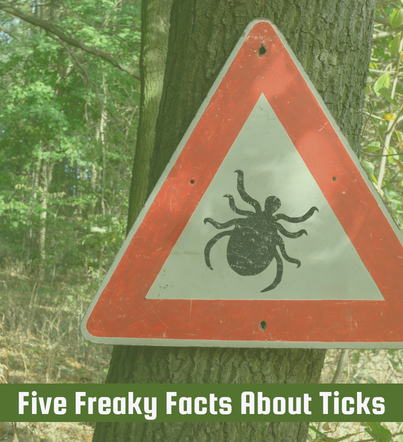Ticks are very common in many parts of the United States. It’s not very pleasant to find one crawling on you, and even less pleasant to find one making a meal out of you! While ticks can be harmful to their hosts, and they can be quite creepy pests, they can also be very interesting. Read on for five freaky facts about ticks.
Ticks are Arachnids, Not Insects
It may surprise you to learn that ticks are not insects. They are actually arachnids, which are the same group as spiders, mites, and scorpions. How can you tell them apart? The best way to tell arachnids from insects is the number of legs. Arachnids have eight legs, whereas insects only have 6.
Ticks Sense Their Prey
Did you know that ticks can sense their prey from a long way off? Most tick species can sense an animal or person coming before they get there. Ticks can’t see well, but they can sense things like body odor, body heat, and vibrations to know when prey is nearby.
Ticks catch a ride on their host through a process called questing. They wait on a blade of grass, or a bush with their front legs outstretched. Then, they grab onto the host when they pass by.
Ticks Can Survive Without Food for Long Periods
Most tick species can go a long time without food. Some ticks can go months, and some can go years. One African species of ticks lived in a lab without food for eight years! Ticks’ ability to live without food for long periods can make it hard to control them.
Ticks Transmit Many Diseases
You’ve probably heard that ticks can spread diseases before. Different species of ticks spread different diseases. The following is a list of some common tick-borne diseases in the United States:
- Lyme Disease
- Babesiosis
- Ehrlichiosis
- Rocky Mountain Spotted Fever
- Anaplasmosis
- SouthernTick-Associated Rash Illness
- Tick-Borne Relapsing Fever
- Tularemia
Ticks Have a Unique Feeding Process
Many people think that ticks feed the same way as mosquitoes, but that is not correct. Mosquitoes feed by inserting their mouth parts directly into a blood vessel, which is different from how ticks feed.
Ticks have a unique feeding process. Once ticks have found a host, they search for a prime feeding spot. Then, they use their sensory palps to guide their chelicerae. They use the chelicerae to cut through layers of skin and flesh. Then, a part called the hypostome is inserted into the hole created by the chelicerae. The tick uses salivary secretions to damage blood vessels, which creates a pool of blood for the tick to feed from.
Although ticks are interesting creatures, it is important to remember that they are pests and can be harmful to their hosts. That includes you and your pets. Remember that many species of ticks spread diseases. It’s best to treat your property for ticks and other unwanted creepy crawlies.
Emerald Tree and Shrub Care Company has the organic tick control services you need. Visit our website to get a quote. Learn more about Emerald Tree and Shrub Care Company and our tick control services.










